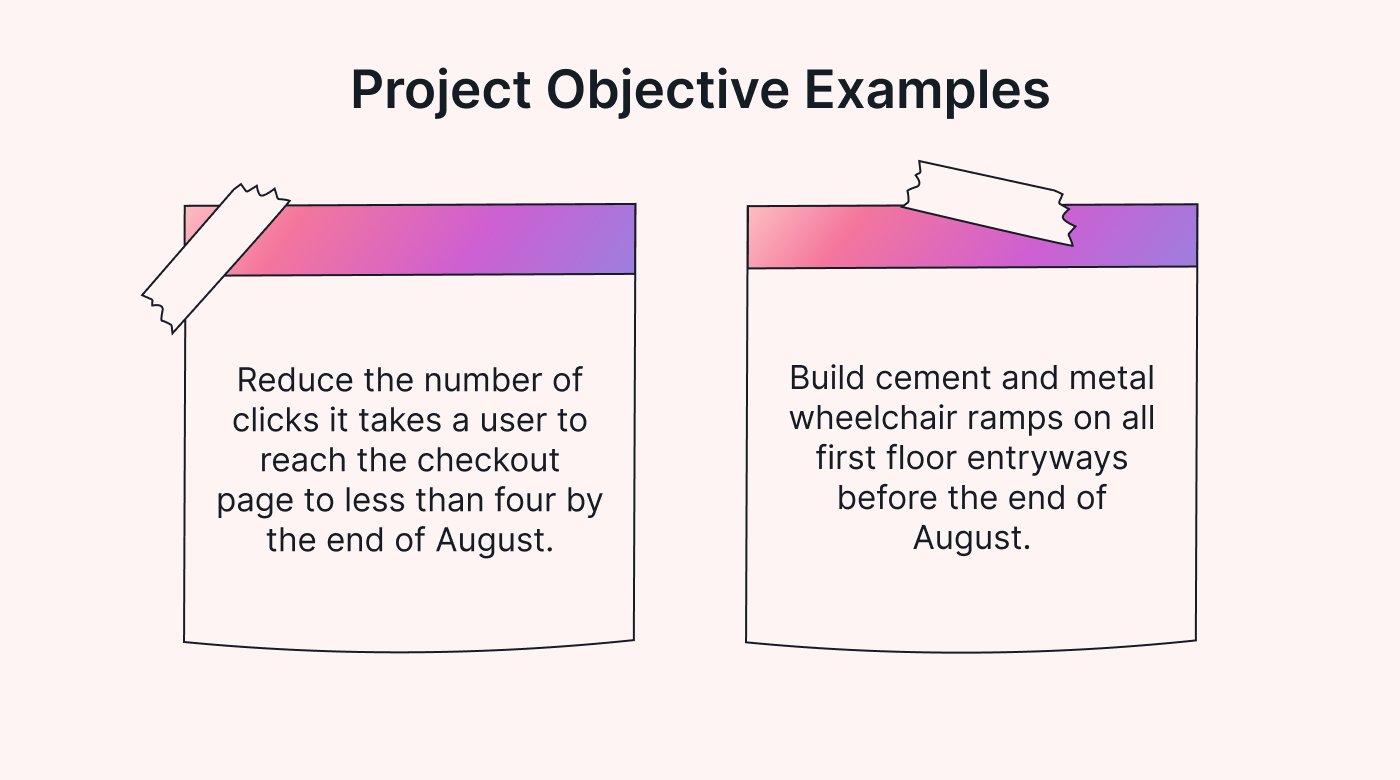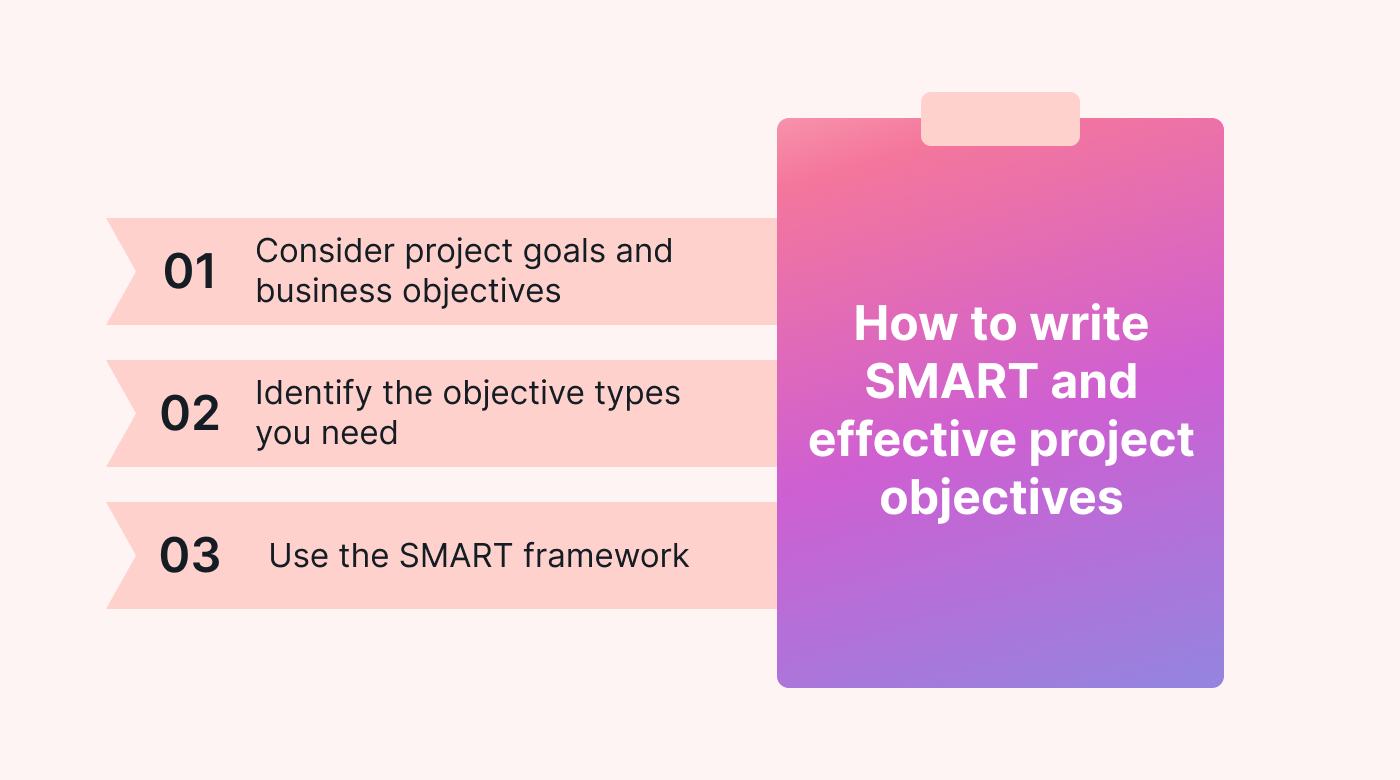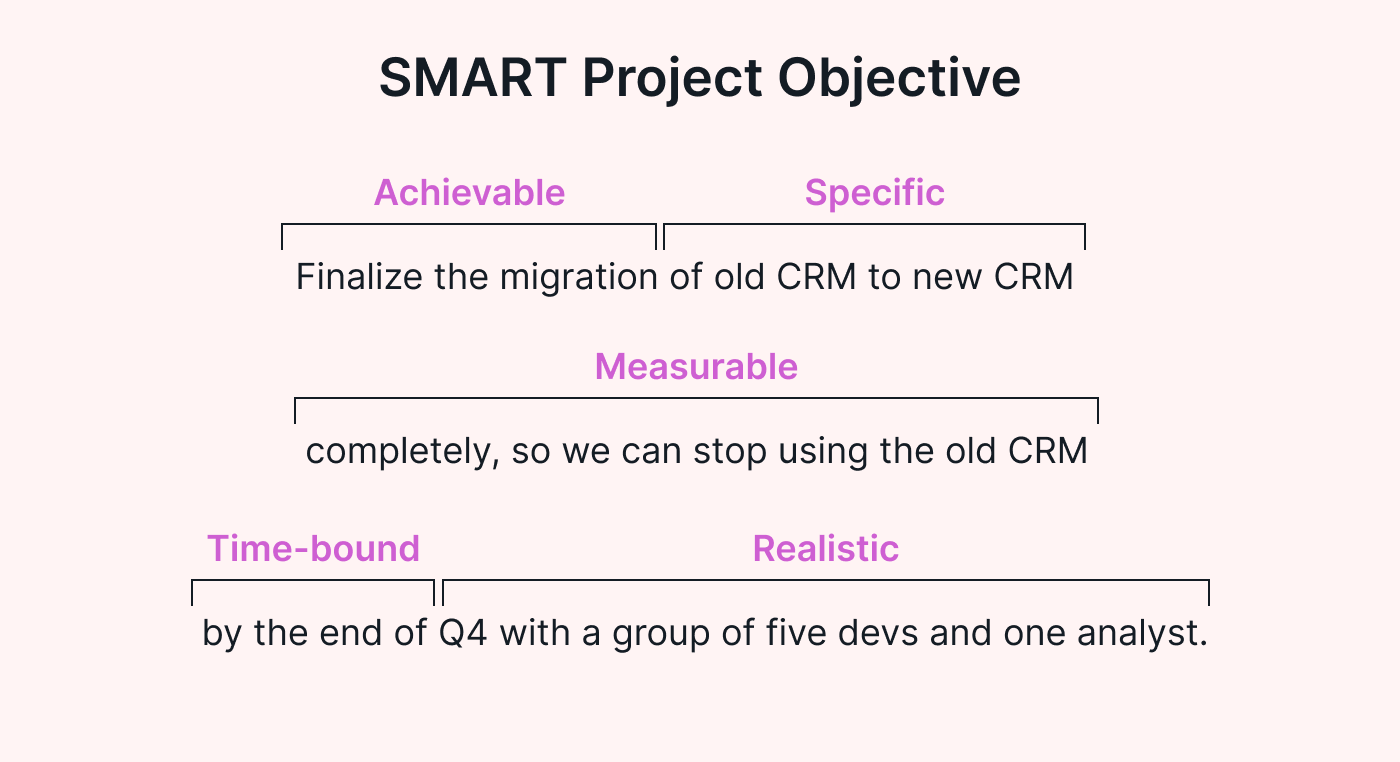To get where you want to go in business, you first need to know where you’re going, how you’ll get there, and how long it will take. That’s why you need project objectives right from the start.
Without clear, SMART, and effective project objectives, you can’t know if your project is progressing as it should or even when it’s finished. That’s why project objectives are critical to project management cycles and can affect a project’s overall success.
In this guide, you’ll learn what project objectives are and how to create SMART project objectives that will motivate your team to accomplish everything you set out to achieve. We also share examples of project objectives to give you an idea of what they look like.
What are project objectives?
Project objectives in project management are what you plan to achieve by the end of a project. They’re defined during project initiation while creating the project charter. A project objective is a statement that describes explicit and tangible outcomes. They identify concrete actions expected from the team.
Project objectives look like this:
- Reduce the number of clicks it takes a user to reach the check-out page to less than four by the end of August.
- Finalize the migration of old CRM to new CRM by the end of Q4 with a group of five devs and one analyst.
- Improve data security by installing and confirming the company firewalls before launching the new email feature.
- Build cement and metal wheelchair ramps on all first-floor entryways before the end of August.
Why are project objectives important?
Project objectives are important because they offer a measurable threshold to monitor a project’s progress and then determine whether the project was a success.
 |
Without clear objectives, you and your team will never really know if you achieved what you set out to do. Project objectives also motivate team members to work towards the same goal.
When and how do project objectives fit into the PM strategy?
During the project management life cycle, project objectives are crafted during project initiation. They’re then included in further project documentation as the true North.
Sometimes, project objectives get confused with other project management actions like project goals, the project plan, and the project deliverables. We’ll take a look at how they’re different and how they work together.
Project objectives vs. project goals
Project objectives and goals are distinct yet interrelated components. A project objective outlines specific results the project aims to achieve, while project goals represent broader aspirations and desired outcomes of the overall project.
The objectives lead towards the completion of the goal like this:
If the goal is:
- Increase customer satisfaction ratings by 10% within six months.
Two relevant objectives would be:
- Improve response time to customer inquiries by reducing the average to under 24 hours.
- Enhance customer experience by introducing a customer feedback tool.
Project objectives vs. business objectives
Project objectives are specific time-bound targets for a particular project but are also designed to contribute to achieving business objectives. Business objectives are broader and encompass how an organization can achieve strategic direction and aspirations.
Using the same example as before, the business objective that sits above the individual project goals and objectives would be:
- Increase customer retention and loyalty by improving overall customer satisfaction and experience (by a specific percent in a specific timeframe).
How that should be done will be specified in the project objectives of the projects selected to support the business objective(s).
Project objectives vs. project plan
Since project objectives are crafted during project initiation, they already exist once you start developing the project plan. In fact, the project objectives and goals are the foundation for the project plan itself.
In a project plan document, the objectives are at the top, easy to reference, and work towards along with your team.
The objectives set the direction, and the project plan provides a structured approach to implement and manage the project, ensuring the desired objectives are achieved on time and within scope.
Project objectives vs. project milestones
The project manager must create a roadmap with phases, deliverables, and milestones to achieve project objectives. A project objective defines what must be achieved by the time the project is complete. The milestones describe points in time when significant sections of the work are completed.
Project milestones are specific points in time in a project roadmap that indicate specific achievements toward the completion of a project. The project objectives give direction to the roadmap and its milestones.
Project objectives vs. project deliverables
A project deliverable is a tangible or intangible output resulting from the project work. They are the specific products, services, or features the project intends to deliver.
Concerning the project objectives, the objectives provide purpose and direction, while the milestones indicate progress, and the project deliverables represent the specific results.
Types of project objectives
Remember those business objectives? Projects are performed to support the business objectives (otherwise, why do them?). So projects are selected because they support one or more business objectives. Some more sample business objectives might be:
- Capture a specific percent portion of the (abc) market within (n) years by introducing new products that target the (xyz) customer segment.
- Achieve system compliance with all (abc) 2030 regulations by January 1, 2029.
Project objectives generally are lower level objectives that contribute in some way to the achievement of these business objectives.
Some projects have one objective, while others have several. They might have several because they support more than one business objective, or they might simply have several related targets to achieve.
Too many objectives can disrupt effective execution, so keeping it to 3 or 4 objectives per project is best.
Objectives can be operational, strategic, or tactical.
- Operational objectives focus on immediate results, such as those found in iterations of agile projects.
- Strategic objectives connect project outcomes to the bigger picture – they support the organization’s strategy.
- Tactical objectives most often appear in complex projects that have multiple short-term deliverables that together satisfy a larger goal.
Project objectives can also be functional or non-functional. Functional objectives are tied to the results of the project itself; i.e., what is produced by the project outcome or deployment of the deliverables.
Non-functional objectives are about the execution of the project itself, such as budget and schedule targets, or improved project processes.
 |
Project objectives are also categorized according to their function, like performance, financial, effectiveness, quality, and regulatory (or compliance).
Performance objectives
Performance objectives have two subtypes: the team's performance during the project lifecycle and the performance of the project output or deliverable.
Team Performance objectives focus on the team members’ work to ensure their actions are directly related to the project objective and its outcomes. Here is an example of a team performance objective:
- Establish realistic project timelines and ensure all tasks and milestones are completed on schedule to meet project deadlines.
Performance objectives that pertain to the project output can often be combined with quality objectives. Here’s an example:
- Design and deliver the project output in a scalable and flexible manner, allowing for future growth, adaptability, and integration with existing systems or processes.
Such an objective should have key performance indicators and be specific about the systems or processes for integration.
Financial objectives
Financial objectives are monetary business targets that you want your project to deliver. These types of objectives align with the organization’s bottom line. They can also be project budget objectives. An example of a financial objective is:
- Design and deliver (a specific new feature) for (xyz product) that increases the revenue from (xyz) by 25% in the first six months of availability as compared to the final six months of 2023.
Effectiveness objectives
Effective objectives help measure and track the effectiveness of the outcome of your project. For example, how well did you achieve your sales target numbers, or any other metric. Here are examples effectiveness objectives:
- Produce and test the vaccine such that it is 72% effective in preventing hospitalization from (xyz) disease.
- Reduce the raw material (abc) wastage from the manufacture of product (xyz) by 10% in 2025 compared to 2023 results.
Quality objectives
Quality objectives deal with quality targets that ensure the project deliverables meet or exceed predefined quality standards and customer expectations. Here’s an example of a quality objective:
- Implement effective quality assurance and manufacturing processes such that defects occur in less than 1 in 10,000 samples.
Regulatory objectives
Regulatory objectives involve government regulations like public health and public safety. These objectives apply to projects that are directly affected by gov’t regulations and look like this:
- Identify and secure all required permits, licenses, or approvals from regulatory authorities before executing the project.
- Ensure that all human resources systems meet or exceed GDPR compliance by January 1, 2025.
How to write SMART and effective project objectives
Now that you know the types of objectives that your project needs, it’s time to write your own. You’ll need one main objective and a few accompanying objectives that all align with the project and business goals.
Follow these steps to craft effective and SMART project objectives for your projects.
 |
Consider project goals and business objectives
The first step when writing project objectives is to consider the project and business goals plus the business objectives, so they align. There’s a hierarchy to these components, and it looks like this:
- Business Goal
- Business Objectives
- Project Goal
- Project Objectives
- Project Goal
- Business Objectives
Let’s use an example of an organization with a web and mobile application that wants to grow its business.
- The business goal: Achieve sustainable growth by increasing revenue and market share in the target market.
- One business objective: Increase customer satisfaction and loyalty by enhancing the overall user experience of our mobile application, resulting in a 20% increase in customer satisfaction scores and a 15% increase in user retention rate within six months.
- A project goal: Redesign and optimize the UI/UX of our mobile app to improve brand loyalty and equity over time.
- One project objective: Conduct user research, gather feedback, and implement design improvements and metrics to enhance the usability and aesthetics of the app on both iOS and Android before the launch of Version 2.1 in April.
Identify the objective types you need
You’ll also need to identify the types of objectives you’ll need for your project to align with the project goal and business objectives.
Continuing the example above, the project objective is a business objective as it aligns UX research with improvement that leads to brand loyalty.
Let’s add two more.
Let’s say this organization also has ambitious financial and quality assurance goals. One objective can be a strategic financial objective, and the other an operational quality objective. They would look like this:
- Implement persuasive UX/UI elements that encourage users to explore premium features, make in-app purchases, or upgrade to higher subscription tiers, resulting in a 10% increase in revenue by 2025.
- Achieve a 99% crash-free user experience and a maximum response time of 2 seconds for critical app functions.
Use the SMART framework
The most effective way to write project objectives is to use the SMART framework. SMART helps you write project objectives that are specific, measurable, achievable, realistic, and time-bound.
 |
Initiate projects effectively with clear project objectives
Project objectives are essential at project initiation and a foundation for all other PM steps toward completion. Start projects correctly by creating SMART project objectives that help you monitor, track and assess project progress until the end.
A SMART project objective looks like this:
Finalize the migration (Achievable) of old CRM to new CRM (Specific), so we can stop using the old CRM (Measurable) by the end of Q4 (Time-bound) with a group of five developers and one analyst. (Realistic).
Here’s how to apply each element to your objectives.
- Specific: Use detailed terms to be specific and concise about exactly what the project aims to achieve.
- Measureable: Include a measurable characteristic that will help track and measure if the objective is achieved.
- Achievable: Ensure that the objective is achievable by the team. Don’t overshoot to the point where the objective is beyond their grasp.
- Realistic / relevant: Ensure that the objective is realistic by aligning it with the available resources, constraints, and timeframe.
- Time-bound: Set a deadline for the objective inside the objective statement itself. This element guarantees that the objective is achieved when it’s meant to.
Initiate projects effectively with clear project objectives
Project objectives are essential at project initiation and a foundation for all other PM steps toward completion. Start projects correctly by creating SMART project objectives that help you monitor, track and assess project progress until the end.
When using Motion to plan and manage projects, the knowledge you gather about your team can help you craft the project objective for an upcoming project. Information about how previous projects progressed and how the team performed gives you a solid foundation to write specific, measurable, achievable, realistic, and time-bound objectives.
Include the project objectives in Motion tasks as attachments so it’s always available for reference and set a deadline. Create a work breakdown structure with tasks and subtasks that stem from the objective and align with it. This practice will help your team stay accountable and on track.
Get started with Motion today and achieve all your project objectives effectively.





